So you want to start writing on Substack but don’t know where to start?
You’re right.
Substack is an incredible platform for writers and one of the best ways to start writing online this year.
I created my Substack account back in 2021.
And as I’m writing this, I’m adding 300-500 new email subscribers on Substack each month.
Here are the best tips to get started as a brand new writer:
What is Substack and how does it work?
Substack allows you to publish both long and short-form written content.
It’s like if an autoresponder (like Kit) and Twitter (err, X) had a baby.
Your long-form articles get distributed to your subscribers.
You can write short-form notes, engage with others, and write your long-form blog posts. (More on that later.)
However, the one thing that makes Substack different from any other platform out there is that you own your audience.
Unlike platforms like:
- X
- TikTok
- YouTube
You can EXPORT your subscribers. They’re yours.
Recently, Substack also added video and audio content to the mix – so as I’m writing this, it seems that they want to become a home for all types of media content.
Why should you write on Substack? (vs. Medium vs. Blog)
Writing on your blog is still the best way to build a long-term SEO strategy.
When you’re just getting started, I recommend writing on both Medium and Substack. You can repurpose the same article on both platforms. Some people are reluctant to do this, but there is absolutely no harm in doing it. This allows you to reach more people with your article.
Now, what about your blog?
I like the idea of making your blog your own piece of real estate on the internet. It’s the only platform that you truly own. But simply posting on your blog without having a solid SEO strategy won’t do the trick.
So if you know your SEO game, then stick to your blog.
But if you want to write more social-type blog posts, growing your newsletter subs, then adding Substack to the mix makes total sense.
You can also use your Substack as your newsletter platform and embed the signup form on your blog.
Even though that’s not something that I recommend because Substack still lacks a lot of features that make autoresponders useful like:
- Tags
- Automations
- Third-party integrations
But if you’re just getting started, it might just be good enough for you.
In order to create your newsletter on Substack, you first need to create your account. I know, I know, sounds crazy, right?
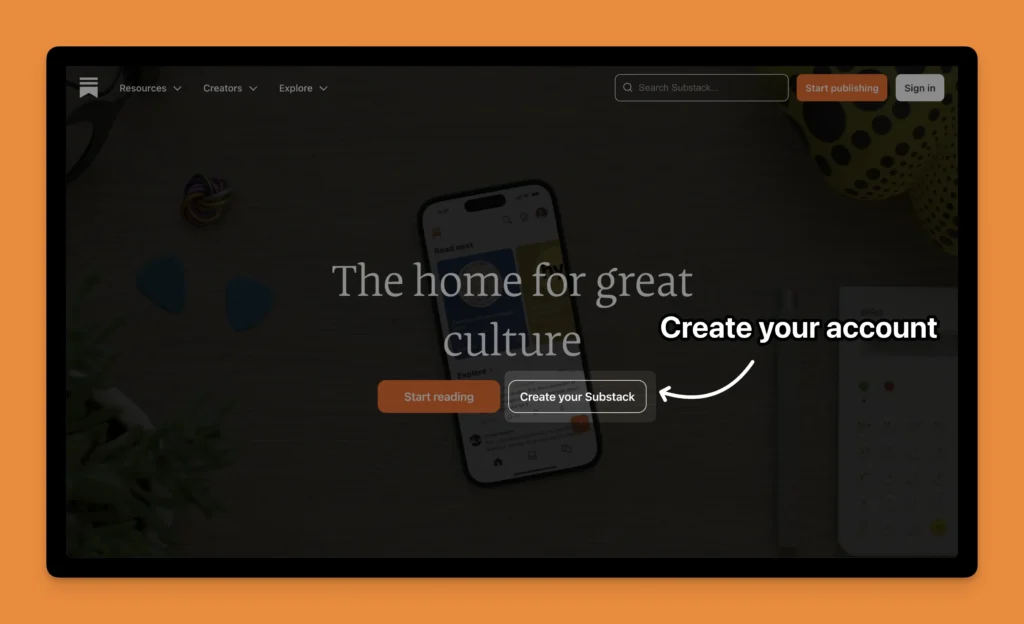
If you’re reading this, then I assume you know how to click a few buttons. It’s pretty straightforward.
- Type your email
- Enter your name
- Choose a password a bit more secure than 1234567
- Study the terms and conditions that you’ve read (or skip them like I did)
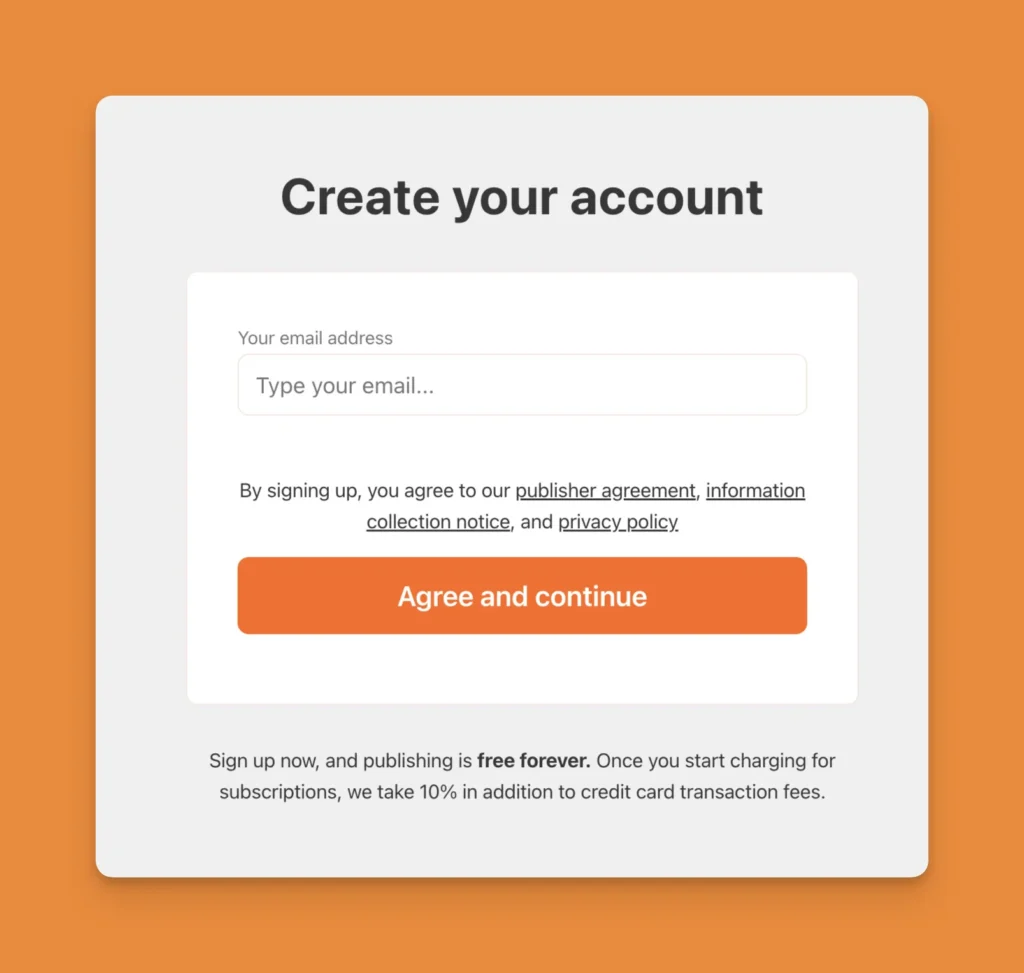
Once you’ve created your Substack account, you can create what’s called a publication.
This is going to be where you’ll post content and write newsletters.
Substack will ask you two things:
How to name your Substack
First, the publication name. So you want to make sure to pick a good newsletter name.
The best way to pick a name is either to go with your own name (this would be very interesting if you’re building a personal brand) or what you could do you could also use the name of your publication.
If you are giving real estate investing tips, then it could be interesting to actually find a catchy name for your newsletter.
In case you need some help picking your Substack newsletter name, you can use the free generator I’ve created on this link.
Once you have your name, Substack will ask you about your publication URL.
I’d simply recommend using your name.
I’ve chosen “mattgiaro.substack.com” as the URL, and “Ideas To Income” as the publication name.
Once chosen, click continue and you’ll be redirected to the publisher dashboard:
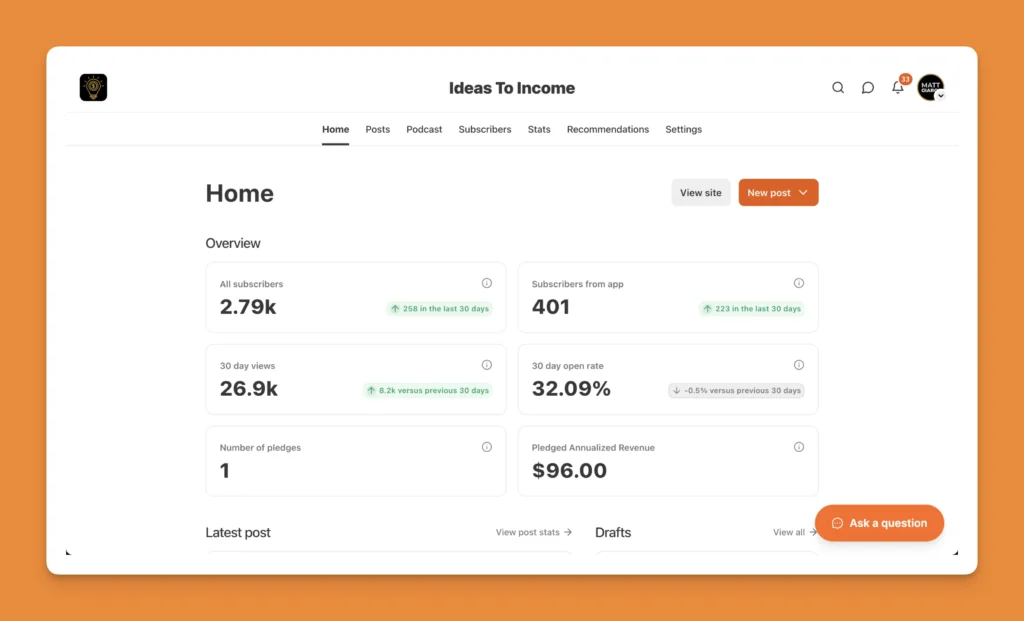
That’s the cockpit for all your content.
But don’t start posting yet. Because there’s something more important to fix first.
How to write an attention-grabbing Substack bio
Your bio is the first thing that people are going to see:
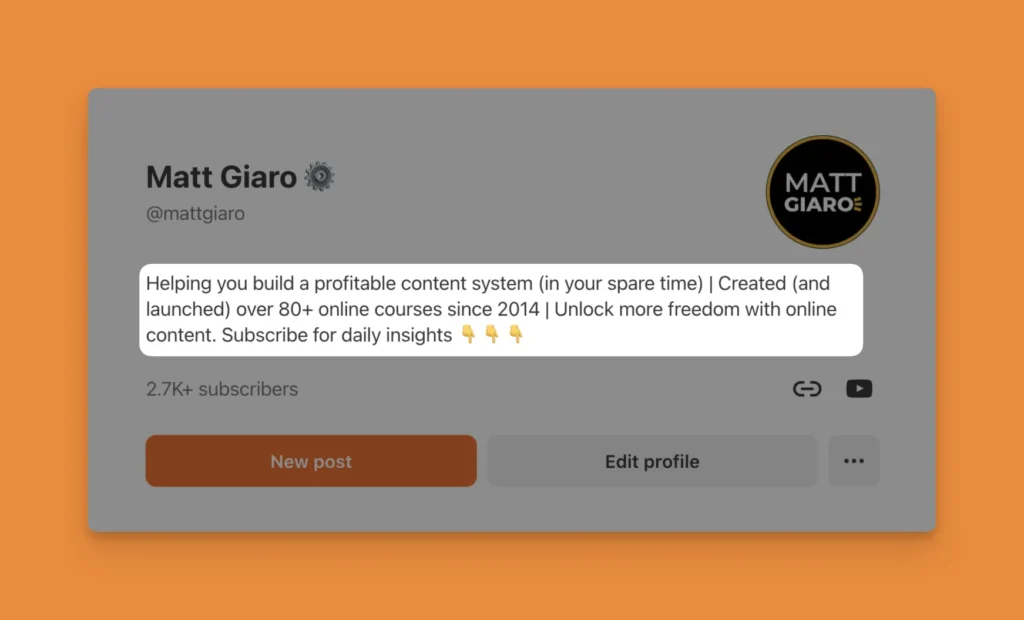
That’s why you want to make sure it grabs the attention of your target audience.
But PLEASE avoid the stupid “Cat lover. Exploring the world” garbage. Nobody cares about that.
The easiest way to create a compelling Substack bio is to talk to your reader.
State the content that you’re going to write about. Identify the audience that you’re talking to.
BONUS TIP: If you have some juicy credentials, squeeze them in there!
As an example…
If you’re a fitness coach and help men over 50 lose belly fat, then simply start with “Fitness coach with 15 years of experience. Helping men over 50 get rid of belly fat.”
That’s it.
Add a profile picture that is the same across all your different internet channels so that people can easily recognize you.
Now you have:
- A subdomain for your Substack
- A compelling Substack profile to attract readers
Now, it’s time to start creating content.
How to publish your first post on Substack
Substack allows you to post different types of content.
You could start a podcast. You could start publishing long and short-form videos. But what Substack is mainly known for is written content.
In your publisher dashboard, head over to “new post” and then choose the type of content you want to get out there:
- Text post refers to a long-form blog article
- New note refers to a short-form X-style post
The editors are straightforward as on other platforms.
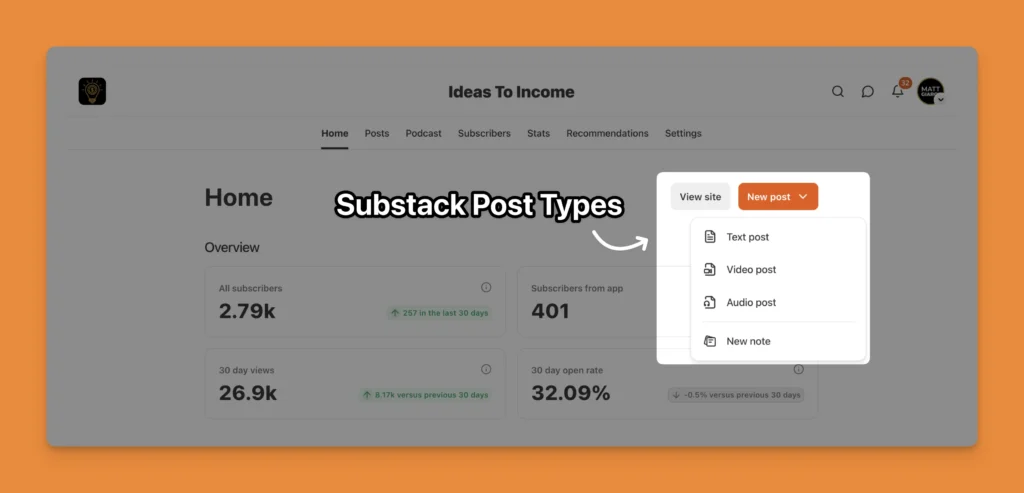
Simply click on New Post and then choose the type of post that you want to post from the drop-down.
How To Write Your Substack Newsletter
There are many ways to approach writing your Substack newsletter.
I write conversational emails.
But another option is to use a specific template for your emails. For example, Jamie Northrup’s Minimalist Hustler Daily follows this format:
- First, he shares one of his articles
- Then an article from someone else
- And finally, something from his sponsors:
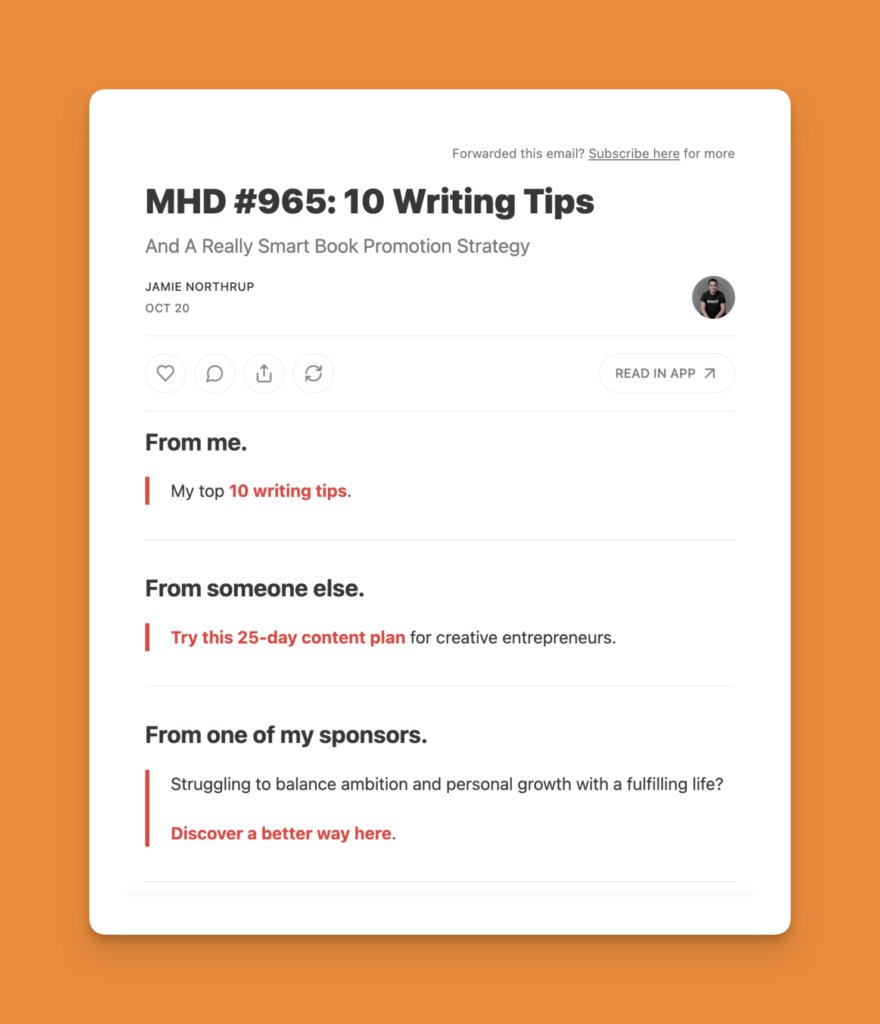
You can find inspiration from many other newsletters, but ultimately, you’ll want to develop your own style.
Another approach is to send out blog posts. That’s also something I do:
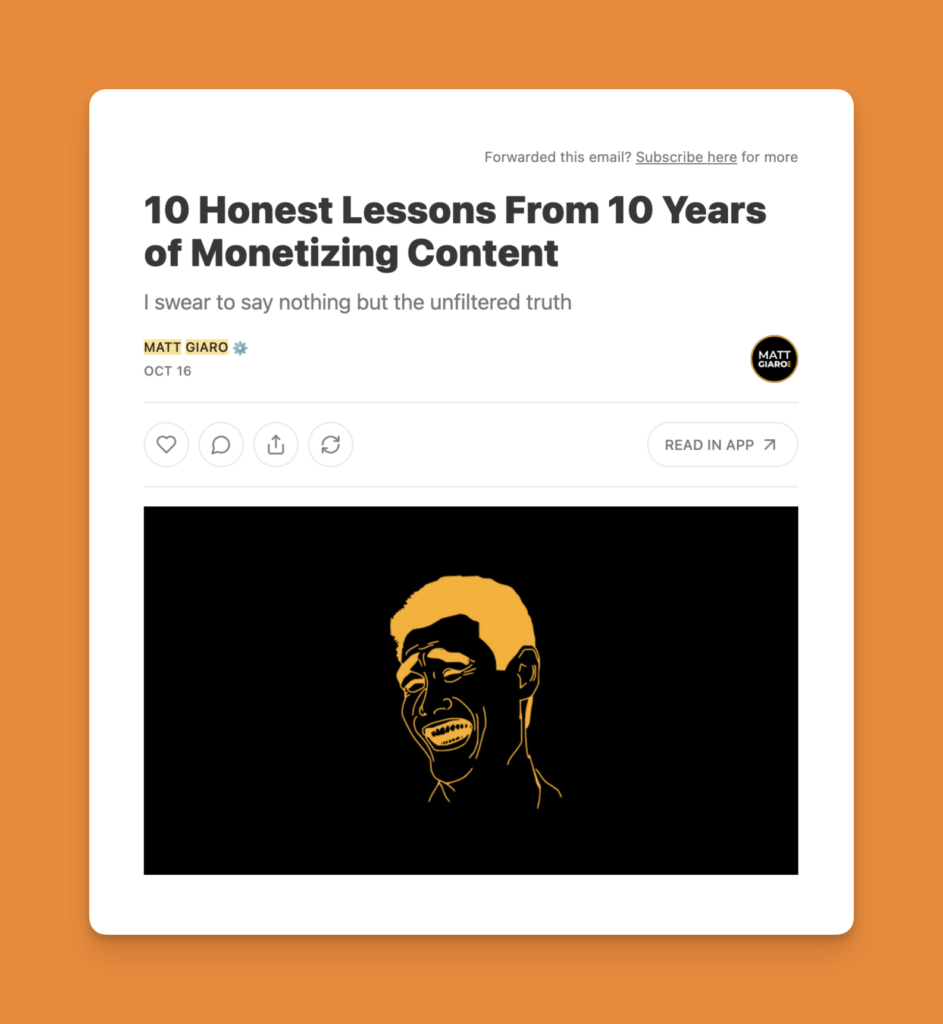
The two most popular formats for these are how-to tutorials or listicles, like “7 Tips to Achieve X” or “5 Mistakes to Avoid When Doing Y.”
The most important thing is to have interesting ideas. Then, you could even use AI to write your weekly Substack newsletters in roughly 5 minutes.
How often to post on Substack?
I’d recommend posting daily notes, and 1-2 long-form pieces a week.
Keep in mind that as with every blogging platform, aim to write at least 100 pieces to start getting traction.
The reason is that competition is fierce. Every niche is saturated.
And you probably need to write 100 pieces to simply become good at it.
That’s why enjoying the game is mandatory if you want to play it long-term.
How to get subscribers (and grow on Substack)
There are two case scenarios on how to get your first 1,000 subscribers on Substack.
Either you already have an audience, or you don’t.
1. Import existing subscribers to Substack
Let’s suppose that you have a LinkedIn audience.
Then what you can do is simply redirect this audience to your Substack.
But if you already have an email list, then this gets way easier. Because you can import your email list into Substack directly using their import feature.
That way, you’re not starting from scratch.
2. Growing on Substack from scratch
But what if you don’t have an audience and you’re just getting started writing on the internet?
Then what I would recommend is to start using Substack Notes. That’s the best way to start your content getting seen on Substack.
Substack Notes is like X (Twitter) – but without the stupid character limit.
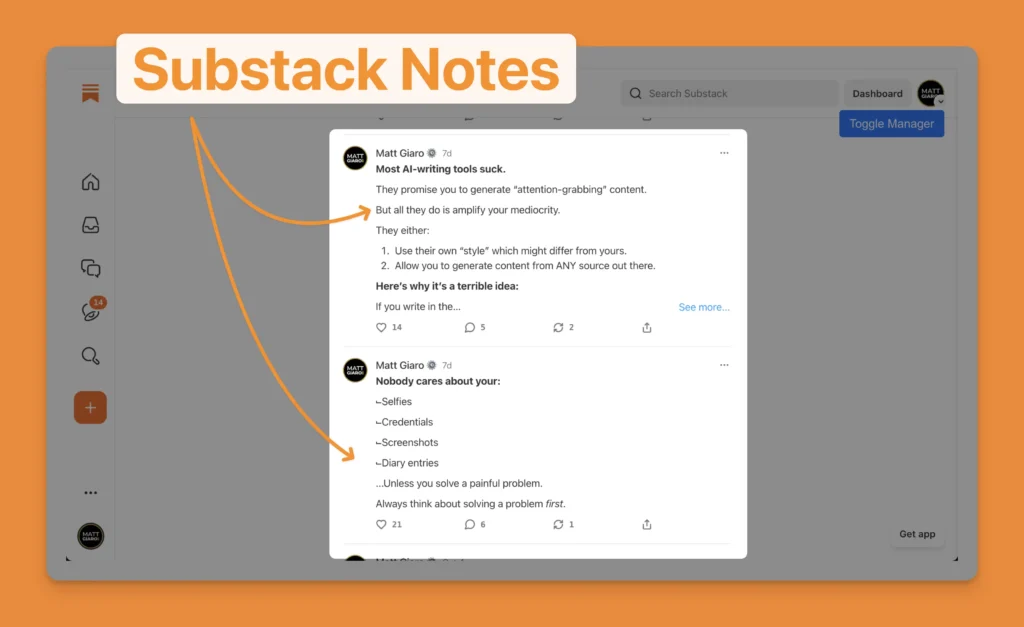
You can share short posts and engage with other creators on the platform.
The strategy to grow with Substack Notes is simple: So what you want to do is find a series of 10 to 20 creators in your industry and then simply interact with them on a daily basis. Then you also want to post at least 1 to 3 notes every day.
That way, you are going to start to get seen by others who will then ultimately follow and subscribe to your Substack newsletter.
There are many other ways to grow on Substack, but this is how I’d start. It’s the easiest and simplest way.
How to monetize your Substack
When you’re just getting started on Substack, write posts for free to gather an audience.
Growing a Substack on audience won’t happen overnight.
But once you gather an audience of at least 1,000 readers, comes the question of how do you monetize that?
Substack wants you to go a simple route: paid subscriptions.
What it means is that subscribers can pay you directly via the Substack interface to get access to exclusive content behind a paywall.
You can hide any type of content behind the paywall:
- Videos
- Podcasts
- Written text (like specific blog posts)
Most creators price their subscriptions from $5-20 per month.
While it might look great on paper, I still think that Substack newsletter subscriptions are a terrible business model for most creators (especially when you have a small audience).
You’ll make more money building an email list and monetizing it with:
- Courses
- Coaching
- or Consulting
But if you want to go down that road, here’s how it works:
First, link a Stripe account to your Substack publication.
Go to Publisher Dashboard > Payments > Connect with Stripe.
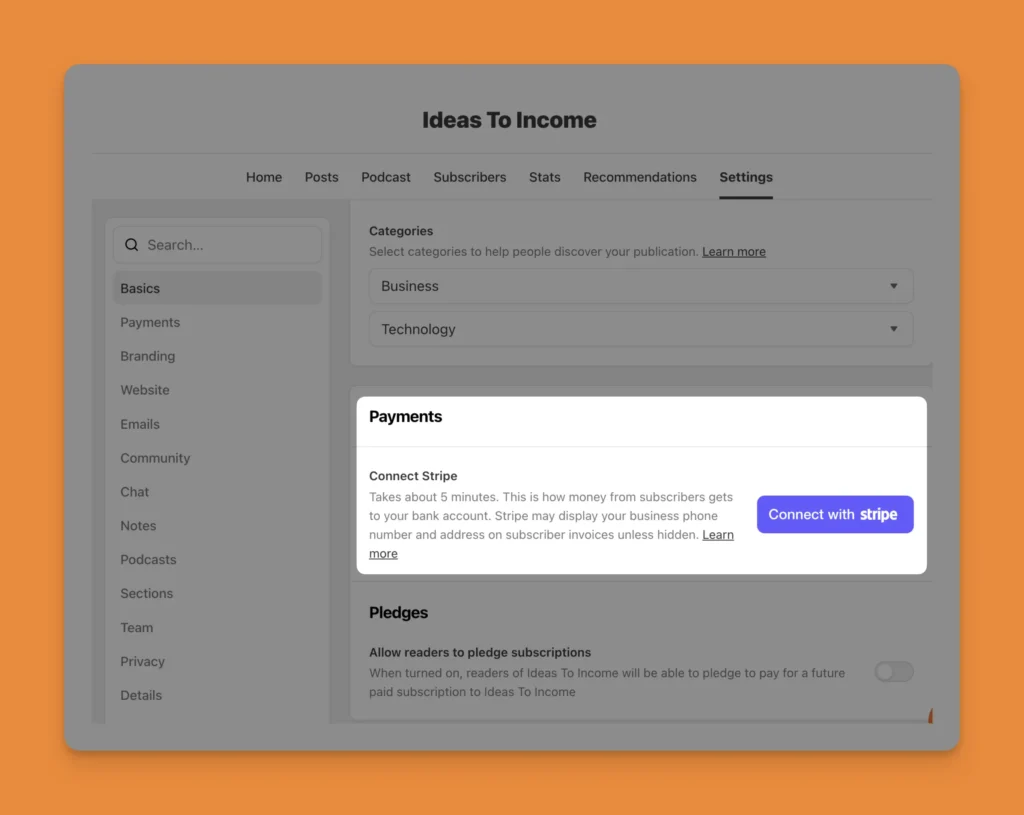
Pledges
In the same section, Substack also allows pledges.
When turned on, subscribers can literally tip you. Think of it as “buy me a coffee.”
Again, it’s not a bad thing. I just think of it as a terrible way to do business.
If you can provide value to your readers, do it by selling your own products. You’ll earn more money and respect.
How much does it cost?
Substack is free. And you can use all features without having to pay a dime.
Substack doesn’t rely on ads.
Instead, they take a 10% cut when someone subscribes to your publication.
Who should start writing on Substack?
Anyone can write on substack.
It’s especially recommended for coaches, creators, consultants, or anyone who wants to build a readership online.
